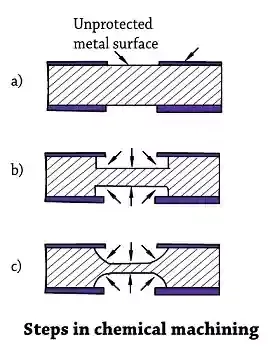Electro Chemical Machining (ECM), Principle of Electro Chemical Machining, Applications of Electro Chemical Machining, Advantages of Electro Chemical Machining, Disadvantages of Electro Chemical Machining
Electro Chemical Machining is an extension of electroplating
process. A electrode is used in the process, which forms cathode. The workpiece
forms anode. A small gap is maintained between the tool and workpiece and an
electrolyte pumped through it. Low voltage DC current is employed which, in the
presence of electrolyte, enables a controlled removal of metal from the
workpiece by anodic dissolution. The electrolyte used possesses such chemical
properties that the constituents of the separated workpiece material do not
stick on to the tool surface. Most widely used electrolyte in the process is
sodium nitrate solution. Sodium chloride solution in water is a good
alternative but is more corrosive than the former. Some other chemicals used in
this process include sodium hydroxide, sodium sulphate, sodium fluoride, sodium
chromate, potassium nitrate and potassium chloride. ECM process can be
successfully used for machining extremely hard metals and alloys, deep holes, small
size and odd shaped holes, etching work and deburring etc. The tools used in
this process should be made of such materials which have enough thermal and
electrical conductivity. Most commonly used materials for this purpose are
stainless steel, titanium, brass and copper. Except for relatively low
stiffness, brass and copper suit best in the process. The tools used should
have a very smooth and highly polished surface as it directly affects the
surface finish of the machined part. In order to control the path of current,
proper insulation of the tool is very essential.
Principle of Electro Chemical Machining:
The principle of ECM process is based on Faraday's Laws of
Electrolysis. The workpiece acts as anode while the tool acts as cathode. The
tool and workpiece are held close to each other with a very small gap [say 0.5
mm] between them. A mild D.C. voltage of about 3 to 30 volts is applied between
the two and an electrolyte continuously pumped into the gap. Due to the applied
voltage the current flows through the electrolyte with [+]vely charged ions
being attracted towards the tool [cathode] and the [-]vely charged ones towards
the workpiece [anode]. The electrochemical reaction, taking place due to this
flow of ions, results in the removal of metal from the workpiece in the form of
sludge. This sludge is taken away from the gap by the flowing electrolyte along
with it. The area where the tool and workpiece are closer experiences flow of
higher current due to low resistance. The metal removal rate in this area is
higher and faster. This enables the reproduction of the tool shape on the
workpiece. The workpiece is held stationary during the process while the tool
is fed at a constant speed in a linear direction.
Applications, Advantages & Disadvantages of Electro Chemical Machining
Applications of Electro Chemical Machining:
• Machining of hard to machine and heat resistant
materials.
• Machining of blind holes and pockets, such as in forging
dies.
• Machining of complicated profiles, such as of jet engine
blades, turbine blades, turbine wheels etc.
• Machining of cavities and holes of irregular shapes.
• Deburring of parts.
Advantages of Electro Chemical Machining:
• Any good electrically conducting material can be machined
and its mechanical properties have no bearing on its machinability through this
process.
• Intricate and complex shapes can be machined easily
through this process.
• Metal removal rate is quite high in comparison to
traditional machining, specially in respect of high tensile and high
temperature resistant materials.
• The machined work surface is free of stresses.
• No cutting forces are involved in the process.
• High surface finish, of the order of 0.1 to 2.0 microns,
can be obtained.
Disadvantages of Electro Chemical Machining:
• Materials which are non-conductors of electricity can not
be machined.
• Power consumption is very high.
• Corrosion and rusting of workpiece, machine tool,
fixtures, etc., by electrolyte is a constant menance.
• Required initial investment is quite high.
• Extremely fine corner radii, say less than 0.2 mm, can
not be produced.
• Designing and fabrication of tools is relatively more
difficult.
• Specially designed fixtures are required to hold the
workpiece in position, because it may be displaced due to the pressure of the
inflowing electrolyte.
END











1 Comments
Vampires in the Enchanted Castle casino - FilmFileEurope
ReplyDeleteVampires in ventureberg.com/ the Enchanted Castle Casino. Vampires in https://septcasino.com/review/merit-casino/ the Enchanted Castle Casino. Vampires in the 토토 사이트 Enchanted Castle Casino. Vampires in the Enchanted Castle Casino. https://septcasino.com/review/merit-casino/ Vampires in jancasino.com the Enchanted